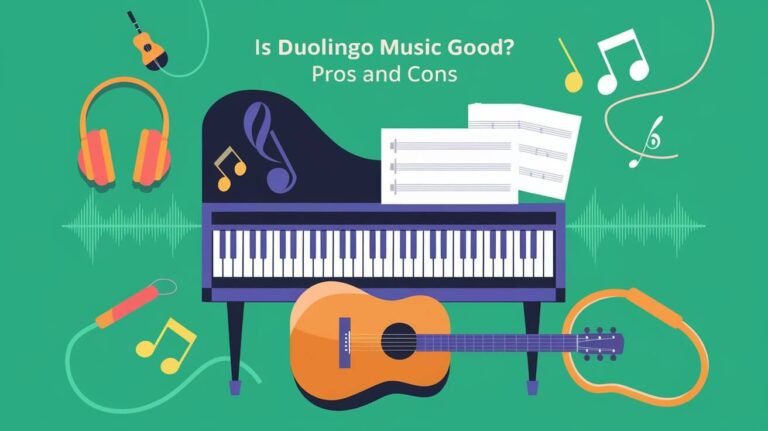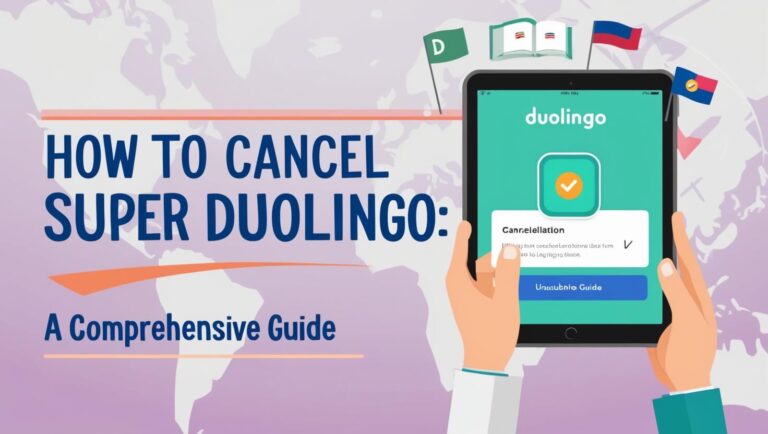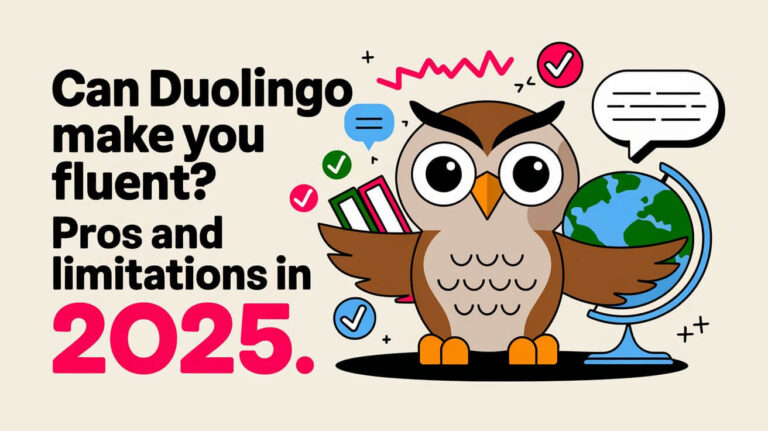Duolingo is a well-known app for learning languages. It offers a free version and a premium option for $6.99/month. It uses games and personalized learning to help beginners start their journey. But does it have enough for those who want to learn more about Korean?
Compared to apps like KoreanClass101 and Korlink, Duolingo gets a 2/5 for effectiveness. But users love its design, giving it a 5/5 for user experience.
Duolingo is great because it’s free and fully functional. This is a big plus compared to Rocket Korean, which costs $99.95 for over 120 hours of lessons. Yet, some say Duolingo’s Korean course doesn’t explain grammar well or help build vocabulary. This might not be enough for those who want to learn more.
In this article, we’ll look at Duolingo’s good and bad points for learning Korean. We’ll also check out its features, what users say, and if it’s worth it for learning a language.
Duolingo Korean Course Structure
The Duolingo Korean course is designed to be progressive. Each skill builds on the previous one. It has 10.7 million learners, making it the 4th most-studied course.
The course layout is organized around a skill tree. This can be confusing for some users. But, the learning units cover nearly 3,000 vocabulary words.
Course Layout and Progression
The course layout is flexible. Learners can customize their study plans with goals of 5, 10, 15, or 20 minutes daily. Lessons range from “not too easy” to “not too challenging,” based on user performance.
Skill Tree Organization
The skill tree is organized into categories like grammar, vocabulary, and pronunciation. Each category has its own lessons and exercises. These are designed to help learners build a strong foundation in Korean.
Learning Units and Lessons
The learning units cover a range of topics and skills. Lessons are interactive and engaging. They use exercises and activities to help learners practice and reinforce their skills.
With the Duolingo Korean course, learners can earn experience points (XP). They get XP through completing lessons, quizzes, and skill practices. This encourages continued engagement.
| Category | Number of Lessons | Topics Covered |
|---|---|---|
| Grammar | 50 | Basic sentence patterns, honorific system, particle usage |
| Vocabulary | 100 | Native Korean, Sino-Korean, foreign loanwords |
| Pronunciation | 20 | Correct pronunciation, intonation, rhythm |
Korean Alphabet Teaching Method
Duolingo’s Korean course begins with the basics of the Korean alphabet. It introduces learners to the unique characters and how to pronounce them. The method is interactive and fun, with lessons that are short and sweet, lasting 5-10 minutes.
The course covers the foundation of Hangul, basic vocabulary, phrases, and simple grammar. This is the starting point for learning Korean.
The Korean alphabet, or Hangul, is key to the language. Duolingo teaches learners the basics of Hangul, including its unique characters and pronunciation. The course is structured like a tree, with themed units that unlock new content as you progress.
Some key features of Duolingo’s Korean alphabet teaching method include: * Interactive lessons that focus on pattern recognition and pronunciation * A detailed introduction to Hangul, covering its unique characters and pronunciation * Lessons that are short and easy to fit into your schedule, lasting 5-10 minutes * A free platform with a lot of content, with the option to upgrade to “Super” for more features
Duolingo’s method is designed to be engaging and interactive. It focuses on introducing learners to the basics of the language. While some might find it too simple, it’s a great way to learn the Korean alphabet and start your language journey.
| Feature | Description |
|---|---|
| Interactive Lessons | Focus on pattern recognition and pronunciation |
| Hangul Introduction | Comprehensive introduction to the unique characters and pronunciation |
| Bite-Sized Lessons | Lessons last between 5-10 minutes, making it easy to learn on-the-go |
Grammar Presentation and Practice
Duolingo’s Korean course covers many grammar topics. It includes basic sentence patterns, the honorific system, and how to use particles. The app makes learning fun and interactive, helping learners build a strong language base.
The app explains grammar clearly with examples. It offers various practice exercises to help learners get better. But, some users find the explanations sometimes unclear. They also think the practice exercises could be more effective.
Key Areas of Focus
- Basic sentence patterns: Duolingo’s course teaches the basics of Korean sentence structure, like word order and grammar rules.
- Honorific system: The app explains the honorific system’s role in Korean language and culture. It also offers practice to help learners use it correctly.
- Particle usage: Duolingo’s course covers how to use particles in Korean sentences. This is key for clear communication.
Duolingo’s approach to teaching grammar is well-organized and engaging. It focuses on building a strong foundation in Korean. While there’s room for improvement, the app’s interactive nature makes it a great tool for learning.
Vocabulary Building System
Duolingo’s Korean course introduces over 3,000 vocabulary items. It uses a spaced repetition system to review words and concepts. This helps learners build their vocabulary through repetition and reinforcement.
The app starts with basic vocabulary and phrases. This is key for learners to feel confident in understanding the language. Duolingo’s system includes:
- Listening and speaking exercises to aid in pronunciation and comprehension
- A focus on common usage vocabulary and phrases
- A point system (XP points) to motivate daily practice
While Duolingo is great for beginners, it might not be enough for advanced learners. To improve, learners can practice with native speakers and attend Korean culture events. Using Duolingo with other resources can help learners become proficient in Korean.
Duolingo’s Korean course can be finished in 3-6 months with daily effort. It offers a solid base for further learning. Duolingo’s interactive exercises and vocabulary building system make it a valuable tool for Korean learners.
Is Duolingo Good for Korean Speaking Practice?
Duolingo’s Korean course has many features to help with speaking practice. It includes pronunciation exercises and speaking activities. These tools aim to improve speaking skills, but some users say it’s not enough.
One big plus of Duolingo’s speaking practice is the chance to practice pronunciation and take part in speaking activities. This boosts confidence and enhances speaking abilities. Yet, some learners might find it hard to reach fluency in Korean.
Pronunciation Exercises
Duolingo’s pronunciation exercises help learners get better at speaking. These exercises let learners practice and get feedback on their progress.
Speaking Activities
Duolingo’s speaking activities help learners practice speaking. They offer a chance to have real conversations and improve speaking skills in a fun, interactive way.
Audio Recognition Tasks
Duolingo’s audio recognition tasks help improve listening skills. These tasks let learners practice listening and get feedback on their progress.
Duolingo’s speaking practice features are useful for those looking to improve their speaking skills. While some might find it limited, it’s a good starting point for many learners.
| Feature | Description |
|---|---|
| Pronunciation Exercises | Practice pronunciation skills and receive feedback |
| Speaking Activities | Engage in conversations and practice speaking skills |
| Audio Recognition Tasks | Practice listening skills and receive feedback |
Cultural Context Integration
Duolingo’s Korean course offers insights into Korean culture and customs. It’s key for learners to grasp the language’s nuances and real-life use. Duolingo’s cultural context helps learners understand the language’s role in Korean society.
The course includes explanations of Korean customs, traditions, and values. Learners discover the importance of holidays like Seollal and Chuseok. They also learn about the respect for elders in Korean culture. This makes learning more engaging and enriches their appreciation of Korean culture.
Some key features of Duolingo’s cultural context integration include: * Explanations of Korean customs and traditions * Insights into Korean values and social norms * Examples of Korean language usage in real-life situations * Opportunities to practice language skills in context
While Duolingo’s cultural context is valuable, some learners might find it limited. To enhance their learning, they can explore Korean language exchange websites or cultural events. This will help deepen their understanding of Korean culture and language.
| Feature | Description |
|---|---|
| Cultural Context Integration | Explanations of Korean customs, traditions, and values |
| Language Usage Examples | Examples of Korean language usage in real-life situations |
| Practice Opportunities | Opportunities to practice language skills in context |
Progress Tracking and Motivation Features
Duolingo’s Korean course has many features to keep learners motivated and track their progress. The XP system, achievement badges, and streak maintenance help learners practice every day. They reward learners for being consistent, making them feel accomplished and motivated to keep learning.
Progress tracking in Duolingo lets learners see how they’re doing and what they need to work on. The XP system shows how far they’ve come, with higher levels meaning they’re getting better. The achievement badges and streak maintenance also push learners to keep practicing, helping them build a strong language foundation.
Benefits of Progress Tracking
There are many benefits to Duolingo’s progress tracking and motivation features. These features keep learners motivated and interested. They also make sure learners practice regularly, which is key for learning a language. Some of the main benefits include:
- Improved motivation and engagement
- Increased consistency in practice
- Clear indication of progress
- Opportunities to earn rewards and unlock new lessons
Streak Maintenance and XP System
The streak maintenance feature in Duolingo encourages learners to practice every day. It rewards them for being consistent. The XP system shows how far learners have come, with higher levels showing more skill. Together, these features make a strong system for tracking progress and keeping learners motivated.
| Feature | Benefit |
|---|---|
| XP System | Provides a clear indication of progress and motivates learners to practice consistently |
| Achievement Badges | Encourages learners to practice consistently and rewards progress |
| Streak Maintenance | Encourages daily practice and provides rewards for consistency |
Real Results from Korean Learners
Many Korean learners have seen great real results from Duolingo. They’ve improved their language skills and stayed motivated. With over 17.4 million active users, Duolingo is a top pick for learning Korean.
Countries like Brazil, France, Germany, India, and Mexico have seen a big jump in Korean learners. This is thanks to Duolingo’s effective learning approach.
Korean learners make good progress with regular practice on Duolingo. Here are some milestones: * Basic Hangul mastery and reading the Korean alphabet in 1-2 months * Basic conversations, like ordering food and asking for directions, in 3-4 months * Intermediate grammar and understanding simple K-pop lyrics in 6 months Duolingo’s Premium features can speed up learning by 20-30% if used well.
While Duolingo’s Korean course is thorough, some learners struggle to remember vocabulary. But, the platform’s achievement badges and XP scoring keep learners motivated. Practicing with a partner and using K-dramas and K-pop can also help with retaining and understanding Korean.
| Practice Duration | Expected Milestones |
|---|---|
| 1-2 months | Basic Hangul mastery, reading Korean alphabet |
| 3-4 months | Basic conversations, ordering food, asking for directions |
| 6 months | Intermediate grammar proficiency, understanding simple K-pop lyrics |
Wrap-Up Thoughts
Duolingo can be a great tool for learning Korean, but it’s not the only thing you need. The app helps beginners learn the alphabet, grammar, and vocabulary. But, it’s not perfect for speaking practice or getting to know Korean culture.
To get the most out of Duolingo, add it to your overall learning plan. Use other tools like talking with native speakers, watching Korean shows, and taking classes. This way, you’ll learn more and become better at speaking and understanding Korean.
Duolingo is a good friend for those learning Korean, but it’s just one part of the journey. Knowing what Duolingo can and can’t do will help you improve your Korean skills. This way, you can reach your goals in learning the language.







